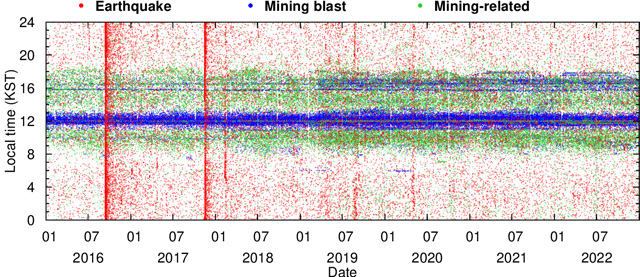20 April 2023–South Korea is a relatively quiet country, seismically speaking, but a recent study identified more than 182,000 small seismic events–135,000 of which were related to mining explosions, according to a presentation at the Seismological Society of America (SSA)’s 2023 Annual Meeting.
After using machine learning techniques to detect tiny earthquakes in seven years’ worth of data collected by 421 seismic stations in the country, Jeong-Ung Woo of Stanford University and colleagues found distinct patterns in event times and locations that allowed them to identify which microseismic events were associated with mining operations. (Microseismicity usually refers to earthquakes of magnitude 2.0 and smaller.)
With relatively few natural earthquakes in South Korea, which is located in the middle of a tectonic plate, seismicity between 2016 and 2022 “was mostly occurring in the daytime, because the mining operations are usually occurring in the daytime,” Woo said.
Seismicity patterns also varied between summer and winter, due to how different sunrise and sunset times affected mining operations, Woo noted. The records showed a distinct drop off in seismic events on Sundays, when the mines are traditionally closed, and “even a little bit on Saturdays,” he added.
Natural seismicity doesn’t follow such regular timing, so microseismicity could be used as “very strong evidence to discriminate earthquakes and explosions without many physical techniques,” Woo said.
The researchers also compared their data with satellite images of mining locations, confirming that the seismic events identified as coming from mining blasts overlapped the location of operations.

occur at all times of the day, while mining blasts most commonly occur over noon or at the end of the
workday. Mine-related events occur during daylight hours. | Jeong-Ung Woo
There were unusual clusters of seismicity at the mining locations, between sunset and sunrise, that didn’t fit the timing of mining operations. “These could be considered mining-related events, or we need to figure out what else could be happening,” Woo said, such as whether mining blasts might be triggering natural seismicity in the area.
The microseismicity data could help seismologists pinpoint previously unidentified active faults or look more closely at earthquake aftershock sequences, he added.
Woo’s study of microseismicity in South Korea was inspired by a paper in the SSA open-access journal The Seismic Record, which showed how machine learning techniques could be used to identify hundreds of thousands of small earthquakes in Oklahoma and Kansas. Yongsoo Park, a former Ph.D. student at Stanford and now at Los Alamos National Laboratory, is a co-author of both studies.
South Korea experienced the largest earthquakes in its instrumental history in the past seven years: the magnitude 5.8 Gyeongju earthquake in 2016 and the magnitude 5.4 Pohang earthquake in 2017. The Pohang earthquake may have been triggered by water injected in rock layers at a geothermal plant. In the wake of the development of earthquake early-warning systems for these damaging and unexpected earthquakes, the country increased its number of seismic stations, creating the dense network that Woo and colleagues used in their study.
With the new microseismicity data, “it reveals previously unreported seismic swarms and activated faults in South Korea as well as capturing characteristic mining activities,” he said.
